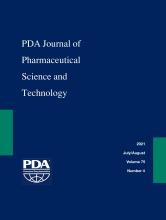Abstract
This article discusses theoretical aspects of saturated vapor–liquid equilibrium for a hydrogen peroxide–water system at temperatures between 16°C and 30°C and humidities between 20% relative humidity to 65% relative humidity, common in pharmaceutical isolator decontamination applications. A discrepancy is pointed out between two competing sets of empirical relations published in the literature that are used to calculate saturated parameters. It is shown how the two published sets can result in four combinations of equations. The four sets of equations were compared to existing published data as well as new data from experiments conducted in this study, and it is shown that one set of relations consistently provided the best match to the experimental data. This set came from a hybrid combination of the previously published equations. This has practical implications for hydrogen peroxide sensors that rely on saturated theory for calibration. In addition, new empirical relations aimed at simplifying the calculation of relevant parameters such as hydrogen peroxide concentration, mole fraction of hydrogen peroxide in the condensed liquid, and relative humidity are presented. The concept of relative saturation is discussed and a new procedure for calculating this parameter during a decontamination cycle is presented, incorporating the results from our experiments. Together the updated theoretical framework and simplified empirical relationships can be used to estimate in a simple, direct, and accurate manner where a decontamination cycle is operating in relation to the 100% saturation level, at which point condensation is likely to form in the isolator. This provides a repeatable and objective measure, useful for monitoring and comparing decontamination cycles.
- Condensation
- Decontamination
- Hydrogen peroxide
- Isolator
- Relative humidity
- Relative saturation
- Theory
- Vapor
- Vapor–liquid equilibrium
- VPHP
- © PDA, Inc. 2021
PDA members receive access to all articles published in the current year and previous volume year. Institutional subscribers received access to all content. Log in below to receive access to this article if you are either of these.
If you are neither or you are a PDA member trying to access an article outside of your membership license, then you must purchase access to this article (below). If you do not have a username or password for JPST, you will be required to create an account prior to purchasing.
Full issue PDFs are for PDA members only.
Note to pda.org users
The PDA and PDA bookstore websites (www.pda.org and www.pda.org/bookstore) are separate websites from the PDA JPST website. When you first join PDA, your initial UserID and Password are sent to HighWirePress to create your PDA JPST account. Subsequent UserrID and Password changes required at the PDA websites will not pass on to PDA JPST and vice versa. If you forget your PDA JPST UserID and/or Password, you can request help to retrieve UserID and reset Password below.






